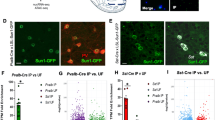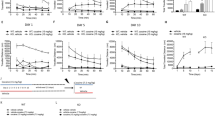Abstract
MeCP2 is a methyl DNA–binding transcriptional regulator that contributes to the development and function of CNS synapses; however, the requirement for MeCP2 in stimulus-regulated behavioral plasticity is not fully understood. Here we show that acute viral manipulation of MeCP2 expression in the nucleus accumbens (NAc) bidirectionally modulates amphetamine (AMPH)-induced conditioned place preference. Mecp2 hypomorphic mutant mice have more NAc GABAergic synapses and show deficient AMPH-induced structural plasticity of NAc dendritic spines. Furthermore, these mice show deficient plasticity of striatal immediate early gene inducibility after repeated AMPH administration. Notably, psychostimulants induce phosphorylation of MeCP2 at Ser421, a site that regulates MeCP2's function as a repressor. Phosphorylation is selectively induced in GABAergic interneurons of the NAc, and its extent strongly predicts the degree of behavioral sensitization. These data reveal new roles for MeCP2 both in mesolimbocortical circuit development and in the regulation of psychostimulant-induced behaviors.
This is a preview of subscription content, access via your institution
Access options
Subscribe to this journal
Receive 12 print issues and online access
$209.00 per year
only $17.42 per issue
Buy this article
- Purchase on Springer Link
- Instant access to full article PDF
Prices may be subject to local taxes which are calculated during checkout








Similar content being viewed by others
References
Hyman, S.E., Malenka, R.C. & Nestler, E.J. Neural mechanisms of addiction: the role of reward-related learning and memory. Annu. Rev. Neurosci. 29, 565–598 (2006).
Robinson, T.E. & Kolb, B. Persistent structural modifications in nucleus accumbens and prefrontal cortex neurons produced by previous experience with amphetamine. J. Neurosci. 17, 8491–8497 (1997).
Huang, Y.H. et al. In vivo cocaine experience generates silent synapses. Neuron 63, 40–47 (2009).
Thomas, M.J., Beurrier, C., Bonci, A. & Malenka, R.C. Long-term depression in the nucleus accumbens: a neural correlate of behavioral sensitization to cocaine. Nat. Neurosci. 4, 1217–1223 (2001).
Nestler, E.J. Molecular basis of long-term plasticity underlying addiction. Nat. Rev. Neurosci. 2, 119–128 (2001).
Moratalla, R., Elibol, B., Vallejo, M. & Graybiel, A.M. Network-level changes in expression of inducible Fos-Jun proteins in the striatum during chronic cocaine treatment and withdrawal. Neuron 17, 147–156 (1996).
Russo, S.J. et al. Nuclear factor kappa B signaling regulates neuronal morphology and cocaine reward. J. Neurosci. 29, 3529–3537 (2009).
Carlezon, W.A. Jr. et al. Regulation of cocaine reward by CREB. Science 282, 2272–2275 (1998).
Pulipparacharuvil, S. et al. Cocaine regulates MEF2 to control synaptic and behavioral plasticity. Neuron 59, 621–633 (2008).
Maze, I. et al. Essential role of the histone methyltransferase G9a in cocaine-induced plasticity. Science 327, 213–216 (2010).
Chahrour, M. & Zoghbi, H.Y. The story of Rett syndrome: from clinic to neurobiology. Neuron 56, 422–437 (2007).
Chao, H.T., Zoghbi, H.Y. & Rosenmund, C. MeCP2 controls excitatory synaptic strength by regulating glutamatergic synapse number. Neuron 56, 58–65 (2007).
Dani, V.S. et al. Reduced cortical activity due to a shift in the balance between excitation and inhibition in a mouse model of Rett syndrome. Proc. Natl. Acad. Sci. USA 102, 12560–12565 (2005).
Tropea, D. et al. Partial reversal of Rett Syndrome-like symptoms in MeCP2 mutant mice. Proc. Natl. Acad. Sci. USA 106, 2029–2034 (2009).
Nelson, E.D., Kavalali, E.T. & Monteggia, L.M. MeCP2-dependent transcriptional repression regulates excitatory neurotransmission. Curr. Biol. 16, 710–716 (2006).
Giacometti, E., Luikenhuis, S., Beard, C. & Jaenisch, R. Partial rescue of MeCP2 deficiency by postnatal activation of MeCP2. Proc. Natl. Acad. Sci. USA 104, 1931–1936 (2007).
Shahbazian, M.D. et al. Mice with truncated MeCP2 recapitulate many Rett Syndrome features and display hyperacetylation of histone H3. Neuron 35, 243–254 (2002).
Samaco, R.C. et al. A partial loss of function allele of methyl-CpG-binding protein 2 predicts a human neurodevelopmental syndrome. Hum. Mol. Genet. 17, 1718–1727 (2008).
Moretti, P. et al. Learning and memory and synaptic plasticity are impaired in a mouse model of Rett syndrome. J. Neurosci. 26, 319–327 (2006).
McGill, B.E. et al. Enhanced anxiety and stress-induced corticosterone release are associated with increased Crh expression in a mouse model of Rett syndrome. Proc. Natl. Acad. Sci. USA 103, 18267–18272 (2006).
Moretti, P., Bouwknecht, J.A., Teague, R., Paylor, R. & Zoghbi, H.Y. Abnormalities of social interactions and home-cage behavior in a mouse model of Rett syndrome. Hum. Mol. Genet. 14, 205–220 (2005).
Zhou, Z. et al. Brain-specific phosphorylation of MeCP2 regulates activity-dependent Bdnf transcription, dendritic growth, and spine maturation. Neuron 52, 255–269 (2006).
Chen, W.G. et al. Derepression of BDNF transcription involves calcium-dependent phosphorylation of MeCP2. Science 302, 885–889 (2003).
Poo, M.-M. Neurotrophins as synaptic modulators. Nat. Rev. Neurosci. 2, 24–32 (2001).
Stearns, N.A. et al. Behavioral and anatomical abnormalities in Mecp2 mutant mice: a model for Rett syndrome. Neuroscience 146, 907–921 (2007).
Tzschentke, T.M. & Schmidt, W.J. Glutamatergic mechanisms in addiction. Mol. Psychiatry 8, 373–382 (2003).
Kauer, J.A. & Malenka, R.C. Synaptic plasticity and addiction. Nat. Rev. Neurosci. 8, 844–858 (2007).
Renthal, W. et al. Delta FosB mediates epigenetic desensitization of the c-fos gene after chronic amphetamine exposure. J. Neurosci. 28, 7344–7349 (2008).
Nicola, S.M., Surmeier, J. & Malenka, R.C. Dopaminergic modulation of neuronal excitability in the striatum and nucleus accumbens. Annu. Rev. Neurosci. 23, 185–215 (2000).
Kawaguchi, Y., Wilson, C.J., Augood, S.J. & Emson, P.C. Striatal interneurones: chemical, physiological and morphological characterization. Trends Neurosci. 18, 527–535 (1995).
Shuen, J.A., Chen, M., Gloss, B. & Calakos, N. Drd1a-tdTomato BAC transgenic mice for simultaneous visualization of medium spiny neurons in the direct and indirect pathways of the basal ganglia. J. Neurosci. 28, 2681–2685 (2008).
Cobos, I., Long, J.E., Thwin, M.T. & Rubenstein, J.L. Cellular patterns of transcription factor expression in developing cortical interneurons. Cereb. Cortex 16 (suppl. 1): i82–i88 (2006).
Cassel, S. et al. Fluoxetine and cocaine induce the epigenetic factors MeCP2 and MBD1 in adult rat brain. Mol. Pharmacol. 70, 487–492 (2006).
Zhang, Z.W., Zak, J.D. & Liu, H. MeCP2 is required for normal development of GABAergic circuits in the thalamus. J. Neurophysiol. 103, 2470–2481 (2010).
Guzmán, J.N. et al. Dopaminergic modulation of axon collaterals interconnecting spiny neurons of the rat striatum. J. Neurosci. 23, 8931–8940 (2003).
Heiman, M. et al. A translational profiling approach for the molecular characterization of CNS cell types. Cell 135, 738–748 (2008).
Norrholm, S.D. et al. Cocaine-induced proliferation of dendritic spines in nucleus accumbens is dependent on the activity of cyclin-dependent kinase-5. Neuroscience 116, 19–22 (2003).
Zhang, D. et al. The dopamine D1 receptor is a critical mediator for cocaine-induced gene expression. J. Neurochem. 82, 1453–1464 (2002).
Hope, B., Kosofsky, B., Hyman, S.E. & Nestler, E.J. Regulation of immediate early gene expression and AP-1 binding in the rat nucleus accumbens by chronic cocaine. Proc. Natl. Acad. Sci. USA 89, 5764–5768 (1992).
Zhang, J. et al. c-Fos facilitates the acquisition and extinction of cocaine-induced persistent changes. J. Neurosci. 26, 13287–13296 (2006).
Hiroi, N. et al. FosB mutant mice: loss of chronic cocaine induction of Fos-related proteins and heightened sensitivity to cocaine's psychomotor and rewarding effects. Proc. Natl. Acad. Sci. USA 94, 10397–10402 (1997).
Kelz, M.B. et al. Expression of the transcription factor ΔFosB in the brain controls sensitivity to cocaine. Nature 401, 272–276 (1999).
Bibb, J.A. et al. Effects of chronic exposure to cocaine are regulated by the neuronal protein Cdk5. Nature 410, 376–380 (2001).
Bracci, E., Centonze, D., Bernardi, G. & Calabresi, P. Dopamine excites fast-spiking interneurons in the striatum. J. Neurophysiol. 87, 2190–2194 (2002).
Wiltschko, A.B., Pettibone, J.R. & Berke, J.D. Opposite effects of stimulant and antipsychotic drugs on striatal fast-spiking interneurons. Neuropsychopharmacology 35, 1261–1270 (2010).
Koós, T. & Tepper, J.M. Inhibitory control of neostriatal projection neurons by GABAergic interneurons. Nat. Neurosci. 2, 467–472 (1999).
Gruber, A.J., Powell, E.M. & O'Donnell, P. Cortically activated interneurons shape spatial aspects of cortico-accumbens processing. J. Neurophysiol. 101, 1876–1882 (2009).
Lois, C., Hong, E.J., Pease, S., Brown, E.J. & Baltimore, D. Germline transmission and tissue-specific expression of transgenes delivered by lentiviral vectors. Science 295, 868–872 (2002).
Acknowledgements
We are deeply grateful to M.E. Greenberg (Harvard Medical School), Z. Zhou and S. Cohen for sharing unpublished data and reagents. We thank N. Calakos (Duke University Medical Center) and F. Polleux (University of North Carolina, Chapel Hill) for providing transgenic mice; K. Vaishnav, J. Zhou, L. Du, M. Fukui, M. Cools, N. Negbenebor, P. Pattabiraman, W.-H. Qian, R. Chereau and M. Presby for technical assistance; and D. Fitzpatrick, G. Feng, J.O. McNamara, A. Brunet and M. Caron for critical reading of the manuscript. Support for this work was provided by National Institute of Drug Abuse grants R01-DA022202 (A.E.W.) and F32-DA025447 (J.V.D.); grant 1-FY07-482 from the March of Dimes Foundation (A.E.W.); along with the Duke University postdoctoral training program in Fundamental and Translational Neuroscience and the predoctoral Pharmacological Sciences Training Program.
Author information
Authors and Affiliations
Contributions
J.V.D. conducted the behavioral and biochemical experiments, performed the stereotactic surgery, ran statistical analyses and wrote the paper. R.M.R. assisted with design and execution of the behavioral experiments and oversaw the statistical analyses. A.N.H. assisted with the behavioral and biochemical experiments and performed the sucrose preference test. I.-H.K. did the Golgi staining. W.C.W. helped to design the study, supervised all behavioral experiments and wrote the paper. A.E.W. designed the study, supervised the project and wrote the paper.
Corresponding author
Ethics declarations
Competing interests
The authors declare no competing financial interests.
Supplementary information
Supplementary Text and Figures
Supplementary Figures 1–8 (PDF 1163 kb)
Rights and permissions
About this article
Cite this article
Deng, J., Rodriguiz, R., Hutchinson, A. et al. MeCP2 in the nucleus accumbens contributes to neural and behavioral responses to psychostimulants. Nat Neurosci 13, 1128–1136 (2010). https://doi.org/10.1038/nn.2614
Received:
Accepted:
Published:
Issue Date:
DOI: https://doi.org/10.1038/nn.2614
This article is cited by
-
Ketamine and rapid antidepressant action: new treatments and novel synaptic signaling mechanisms
Neuropsychopharmacology (2024)
-
Cell-type specific transcriptional adaptations of nucleus accumbens interneurons to amphetamine
Molecular Psychiatry (2023)
-
Cannabidiol inhibits methamphetamine-induced dopamine release via modulation of the DRD1-MeCP2-BDNF-TrkB signaling pathway
Psychopharmacology (2022)
-
Sustained effects of rapidly acting antidepressants require BDNF-dependent MeCP2 phosphorylation
Nature Neuroscience (2021)
-
Ube2b-dependent degradation of DNMT3a relieves a transcriptional brake on opiate-induced synaptic and behavioral plasticity
Molecular Psychiatry (2021)



